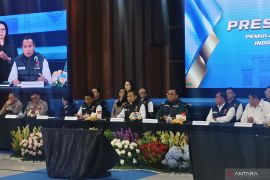"Mangroves will not be able to live if there is no tidal marsh whose carbon absorption is higher. Mangroves can also live if it is connected to seagrass," he said when met after the Tri Hita Karana - World Economic Forum held in the Kura-Kura Special Economic Area (SEZ) here on Sunday.
The minister said that in expanding the water conservation area, which is targeted to reach 30 percent of Indonesia’s total ocean area by 2045, the government also pays attention to coastal areas that have the potential for carbon storage and absorption.
Coastal areas like the tidal marsh, seagrass meadow, and mangrove ecosystems are related to one another.
Minister Trenggono on that occasion also emphasized that the expansion of water conservation zones is one of the blue economy policies.
The Indonesian Government continues to strengthen its blue economy policies to support the utilization of sustainable marine resources.
The target of 97.5 million hectares of conserved ocean area by 2045 can provide more protection for the three coastal ecosystems and also coral reefs.
Indonesia also pays attention to carbon absorption storage, with the potential for additional sector in the second Nationally Determined Contribution (NDC) document which is currently being prepared by the Indonesian Government.
Coastal and marine ecosystems are seen to have the same potential with the forestry and land use, industry, energy, agriculture and waste sectors in efforts to achieve the national greenhouse gas (GHG) emission reduction target.
Responding to this potential, Trenggono ensured that his side continued to coordinate with stakeholders in the field of water conservation.
Related news: Government targets expanding marine conservation areas to 30% by 2045
Related news: Preserving Indonesia's optimism of conserving 30-percent marine areas
Translator: Prisca V, Kenzu
Editor: Rahmad Nasution
Copyright © ANTARA 2024












